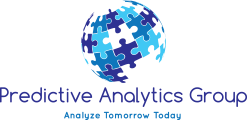Let’s face it—data analytics isn’t exactly cocktail party conversation for most people. But if you’re reading this, you’re probably wrestling with some thorny business problems that keep you up at night.
We’ve compiled the questions our clients ask most frequently as they try to address their “burning platforms.” You know, the kind where your credit losses are climbing but nobody can tell you why. Or where your reporting systems look like they were cobbled together with duct tape and wishful thinking.
At PAG, we don’t build fancy models that gather digital dust. We help you turn data chaos into decisions that actually move the needle. Our GOBLIN platform isn’t just another acronym in your tech stack—it’s clarity for your murky data picture.
So, whether you’re preparing for a compliance audit that’s making your stomach churn or just trying to figure out why your fraud losses keep climbing despite all those solutions you’ve implemented, we’ve got straight answers. No jargon. No hype. Just practical insights from people who’ve been in the trenches.
Browse through these FAQs, and if you don’t see your burning question, reach out. We’re real people who love solving real problems.
There are 13 questions here. Just click on the ones that interest you and it will take you right to the answer:
- Why are my credit losses going up?
- How is GOBLIN different from the major enterprise data platforms we’re already evaluating, and why should we consider a specialized solution over established vendors?
- What does PAG do?
- What are the three most common pain points that you’re seeing from prospects and clients?
- Can PAG help me prepare for a compliance audit or close out an MRA?
- How can I transform or manage my intake process?
- Can you share some success stories or case studies?
- How do you approach working with financial institutions to improve their credit underwriting strategies?
- How can I reduce my fraud losses and expenses?
- How do you approach transforming clients’ tech stacks?
- What do you recommend be included in a portfolio dashboard?
- Do you guys build models or validate them?
- What jobs are people posting for?
1. Why are my credit losses going up?
Your credit losses rarely spike because of one single issue. It’s usually a perfect storm of factors—your acquisition channels shifting without your underwriting keeping pace, economic headwinds affecting your customer base, or competitors cherry-picking your best customers while leaving you with higher-risk ones.
We’ve seen clients whose losses doubled because their decade-old scorecards were quietly becoming less predictive every quarter. Others discovered their collections strategy was broken, treating high-risk and low-risk defaults with the same approach.
Rather than guessing, we’ll help you dissect the actual drivers through our diagnostic analytics. We’ll analyze vintage curves, segment performance, and approval trends to pinpoint exactly where the bleeding is happening. Once we know what’s broken, we can help you fix it—whether that means refreshing your models, adjusting your cut-offs, or redesigning your collections workflow.
2. How is GOBLIN different from the major enterprise data platforms we’re already evaluating, and why should we consider a specialized solution over established vendors?
GOBLIN distinguishes itself from traditional enterprise data platforms in three critical ways that matter to financial services leaders. First, it was purpose-built by senior analytics experts with decades of client-side financial services management experience, meaning it addresses the specific data challenges they face rather than requiring extensive customization of a generic platform. Second, GOBLIN delivers immediate value through pre-configured components including software licenses (Azure, Tableau, relational databases) and 20+ years of financial services accelerators, enabling you to hit the ground running rather than spending months on implementation. Finally, GOBLIN costs a fraction of what you’d pay major competitors while providing the same core functionality—file sharing, data warehousing, and business intelligence—in a SOC2-certified, PCI-compliant environment designed specifically for financial institutions.
Our clients typically see a 30% reduction in infrastructure costs and dramatically faster time-to-insight compared to traditional enterprise platforms. As one CEO noted, “That’s not something you usually see – you often see people push for implementation of a cookie-cutter product. Not PAG.”
For detailed technical specifications and case studies showing how GOBLIN has helped similar institutions, visit our GOBLIN platform page.
3. What does PAG do?
In the simplest terms, we help you turn data into decisions.
Predictive Analytics Group bridges the gap between complex analysis and practical business action. Through our proprietary GOBLIN enterprise data platform, we tackle the problems that keep financial executives up at night:
- Consolidating fragmented data from multiple legacy systems.
- Overcoming limited in-house analytics expertise.
- Creating comprehensive reporting suites with appropriate access controls.
- Identifying new segmentation opportunities to drive growth and profitability.
We’re not just consultants who drop off recommendations and disappear. We roll up our sleeves and work alongside your team to implement solutions that actually stick. Whether you need help with credit risk management, fraud prevention, compliance initiatives, or portfolio optimization, we bring both the technical expertise and the business acumen to deliver measurable results.
Our clients range from community banks to Fortune 500 financial institutions, but they all share one thing: they need to make better data-driven decisions, faster.
4. What are the three most common pain points that you’re seeing from prospects and clients?
If we had to identify the three burning platforms we encounter most frequently, they would be:
- Data Fragmentation Paralysis. Organizations know they’re sitting on valuable information, but it’s trapped in siloed systems that don’t talk to each other. One insurance client described it as having all the puzzle pieces but no picture on the box. This fragmentation leads to contradictory reports, duplicate efforts, and missed opportunities. We help create a unified data framework without requiring massive system replacements.
- Analytics Talent Gaps. Companies are trying to become more data-driven but struggle to hire and retain the right talent. The market for experienced data scientists and analysts remains tight, and many organizations can’t justify the expense of building a complete in-house team. We provide both immediate expertise and knowledge transfer to help build sustainable capabilities.
- The Execution Valley. This is the dangerous gap between insight and action—where good analysis goes to die. Organizations invest in analytics but struggle to translate findings into operational changes. We focus on bridging this valley by designing decision frameworks, implementing monitoring systems, and training teams to act on analytical insights effectively.
What’s interesting is that while technology often gets blamed for these issues, the real challenges are usually more about process and people than platforms. Getting the human elements right is just as important as having the right technical solution.
5. Can PAG help me prepare for a compliance audit or close out an MRA?
Absolutely—and we’ve got the battle scars to prove it.
We’ve helped numerous clients navigate the turbulent waters of regulatory compliance audits. From preparing documentation that answers examiner questions to coaching your team on how to discuss model limitations without creating new issues, we know how to make these processes less painful.
For Matters Requiring Attention (MRAs) or Matters Requiring Immediate Attention (MRIAs), we’ve helped clients develop realistic remediation plans and implement them in ways that satisfy regulators without crippling your business operations.
Our approach isn’t about quick fixes or temporary patches—it’s about building sustainable compliance practices that become part of your organizational DNA. The goal isn’t just to close out today’s MPA, but to prevent tomorrow’s from being issued in the first place.
6. How can I transform or manage my intake process?
Your intake process is often where good opportunities go to die. We’ve seen brilliant strategies strangled by convoluted implementation processes and watched valuable leads evaporate while internal teams debate who should handle them.
The first step is diagnosing what’s broken. Is it a technological issue, with systems that don’t talk to each other? A process problem, with too many handoffs creating delays? Or a measurement challenge, where you can’t see what’s happening until it’s too late?
We help clients streamline intake by implementing intelligent routing systems, automated quality checks, and real-time monitoring dashboards. Our GOBLIN platform can integrate with your existing systems to create a single source of truth for all incoming opportunities—whether they’re loan applications, new account openings, or service requests.
The result? Faster processing times, fewer abandoned applications, and a dramatically improved customer experience that translates directly to your bottom line.
7. Can you share some success stories or case studies?
Our reputation wasn’t built on flashy marketing—it was earned in the trenches, solving problems others couldn’t crack.
Take the regional bank that was losing market share despite competitive products. Its application approval times were killing their conversion rates, and nobody could figure out why. Within two weeks, our analytics identified a bottleneck in its verification process that was causing a 48-hour delay on 30% of applications. After implementing our recommended workflow changes, they saw same-day approvals jump from 40% to 78%.
Or consider the auto lender whose fraud losses had doubled despite investing in three different prevention tools. Our analysis revealed that while they were effectively blocking obvious fraud, they were completely missing synthetic identity schemes. We helped them implement a layered detection approach that reduced losses by 62% within 90 days.
We don’t just deliver reports, we deliver results. And our clients become our best references because they’ve experienced the difference between generic analytics and truly transformative insights.
8. How do you approach working with financial institutions to improve their credit underwriting strategies?
We start with this radical notion: Underwriting isn’t just about saying yes or no. It’s about saying yes to the right customers, on the right terms, at the right time.
First, we diagnose what’s happening in your current process. We analyze approval rates, override patterns, and performance outcomes across different segments. Often, we uncover surprising insights—like the mid-size bank that was declining 30% of applications that their own models scored as low-risk, simply because of outdated policy rules nobody had revisited in years.
Then we help you evolve your strategy through a combination of:
- Model refreshes that incorporate new data sources and advanced techniques.
- Champion/challenger frameworks that let you test new approaches without betting the farm.
- Decision flow optimization that reduces unnecessary manual reviews.
- Policy refinements that align with your risk appetite and growth objectives.
The magic happens when underwriting decisions become more accurate AND more efficient. One client increased their auto-decision rate from 45% to 72% while simultaneously reducing their early delinquency rate by 18%—proof that better analytics can help you grow responsibly.
9. How can I reduce my fraud losses and expenses?
Fighting fraud often feels like playing whack-a-mole—you block one scheme only to find fraudsters have already moved on to the next vulnerability.
The key is moving from reactive to predictive fraud management. Rather than just analyzing historical fraud cases, we help you identify emerging patterns before they become major losses.
Our approach combines:
- Multi-layered detection systems that look beyond individual transactions to identify suspicious patterns across your portfolio.
- Behavioral analytics that establish normality baselines for customers and flag meaningful deviations.
- Network analysis that connects seemingly unrelated applications to reveal coordinated fraud rings.
- Cost-benefit modeling that ensures your fraud prevention efforts don’t create more friction than value.
One client was spending $2.3 million annually on fraud tools but still experiencing rising losses. We helped them consolidate to just two integrated solutions, cutting its technology costs by 40% while improving detection rates by 23%. The math works when you focus on effectiveness, not just activity.
10. How do you approach transforming clients’ tech stacks?
Tech transformations fail when they’re treated as pure technology projects rather than business enablers. We’ve rescued enough failed implementations to know the warning signs.
Our approach is pragmatic rather than revolutionary. Instead of ripping out everything and starting over (which rarely goes well), we focus on:
- Creating a flexible data layer that can extract value from legacy systems.
- Building integration points that allow different systems to share critical information.
- Implementing visualization tools that make data accessible to decision-makers.
- Establishing governance frameworks that maintain data quality over time.
We worked with an insurance provider that had spent $12 million on a failed data warehouse initiative. Rather than repeating that expensive mistake, we helped it implement our GOBLIN platform as a middle layer that could access and organize their existing data sources. Within 60 days, it had dashboards pulling from seven different systems—without having to replace any of its core technology.
Sometimes the most powerful tech transformation isn’t about new systems, but about finally extracting value from the ones you already have.
11. What do you recommend be included in a portfolio dashboard?
The most beautifully designed dashboard is worthless if it doesn’t drive better decisions. We’ve seen too many dashboard projects that produced gorgeous visualizations nobody used.
Effective portfolio dashboards typically include:
- Leading indicators that help you spot trends before they impact your bottom line.
- Segment-level performance metrics that highlight where opportunities and risks are concentrating.
- Vintage curves that separate growth effects from true performance changes.
- Operational metrics that connect processing efficiency to financial outcomes.
- Benchmark comparisons that provide context for your performance numbers.
The exact metrics depend on your business model and strategic priorities. For some clients, geography is a critical dimension; for others, it’s acquisition channel or customer tenure.
What matters most is that your dashboard answers your most important business questions without requiring users to become data scientists. One of our retail banking clients replaced its 42-page monthly report with a single interactive dashboard that executives actually check daily—because it gives them actionable insights, not just data dumps.
12. Do you guys build models or validate them?
Both—and we’re transparent about which role makes sense for your situation.
We build custom models that actually reflect your business reality, not theoretical constructs that look good on paper but fall apart in practice. Our models have helped clients increase approval rates while decreasing losses—the analytics equivalent of having your cake and eating it too.
For validation, we provide the rigorous, independent assessment you need for regulatory compliance and risk management. Unlike some validators who just check boxes, we actually understand how models work in the real world. We’ve been on both sides of this table, and we know the difference between technical compliance and genuine model effectiveness.
What we won’t do is build your models and then validate them ourselves. That’s like grading your own homework, and it doesn’t serve you or your regulators.
13. What jobs are people posting for?
Organizations typically bring us in when they’re missing crucial analytics talent or need specialized expertise they can’t justify as a full-time hire.
We frequently see postings for:
- Data Scientists who can translate business problems into solvable equations.
- Analytics Translators who can bridge the gap between technical outputs and business decisions.
- Dashboard Designers who can turn information overload into actionable insights.
- Model Validators with enough real-world experience to spot practical issues, not just theoretical ones.
Rather than waiting months to fill these roles (and paying premium salaries once you do), many clients find it makes more sense to leverage our team’s combined decades of experience on a project basis. We can tackle your immediate needs while helping you build internal capabilities for the long term.
To learn more about our services, contact us here





